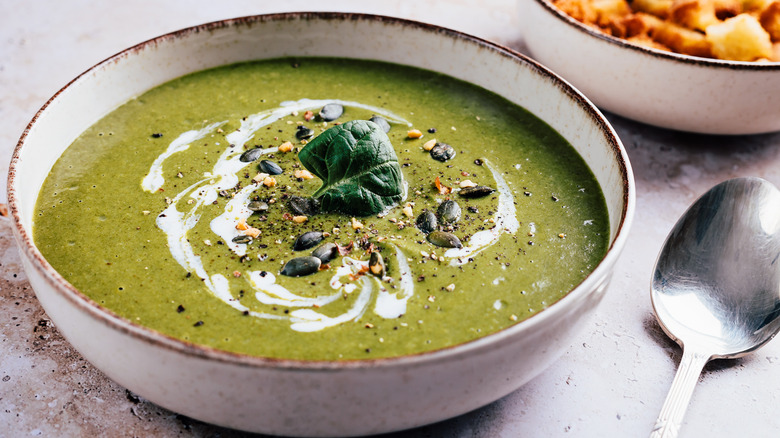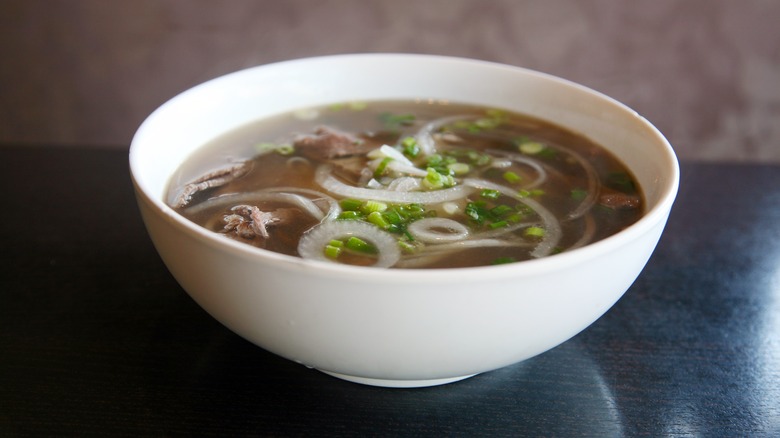The Simple Reason Some Soups Are Traditionally Served Cold
When you think of soup, you most likely picture a bowl of something warm and comforting that you can easily burn your mouth on if you aren't careful. While soup is the perfect meal for those cozy winter nights and those days when you're feeling a little under the weather, many soup lovers abandon the dish once summer rolls around. To be fair, no one wants to sweat over a steaming bowl of potato leek soup at the height of summer, even if it is delicious. Luckily, there are many soup recipes that are actually served cold so you can enjoy soup during all four seasons.
The cold soup that may immediately come to mind is gazpacho, a famously chilled soup dish that comes from the warm and dry Andalusia region of southern Spain. With more than 300 days of anticipated sunshine in the region each year, savvy Andalusian chefs needed to find a more refreshing way to enjoy soup in such a warm climate. Gazpacho, along with many other delicious cold soup recipes, are typically enjoyed cold so that people who live in hotter climates can also enjoy the delicious dish.
The fresh ingredients in a cold soup are perfect for hot climates
Cold soup might sound like a bit of an oxymoron, but the refreshing flavors that a bowl of chilled soup provides on a hot day simply can't be beat. Many cold soup recipes incorporate seasonal produce, fresh herbs, and notes of citrus that are all welcome additions to your summer palate. Most cold soups tend to leave out heavy proteins and butters, as the low-temperature broth doesn't complement the flavors of animal fats as well as a warm broth can.
Some cold soup dishes actually call for broth that's ice-cold, such as the popular Korean dish naengmyeon. This cold noodle soup is extremely popular in regions of Korea, where summers are known to be extremely hot and humid. On the other side of the world, French bisques are also a popular subgenre of soup that's traditionally very smooth and thick, made with a cream base and containing seafood or shellfish, although the definition has loosened over the years. This category of soup can be served hot or cold, which gives us hope for chilled, beachside lobster bisque or a cool-yet-dippable tomato bisque to dip our cheese sandwiches in, even on a warm day.
Is soup technically considered a full meal or a starter course?
Once you incorporate cold soups into your life and start to enjoy the dish year-round, it's time to answer another very important question: Can soup be considered a full meal? The technical definition of what constitutes a soup does leave many questions unanswered. Merriam-Webster defines it as "a liquid food especially with a meat, fish, or vegetable stock as a base and often containing pieces of solid food." Most soups are offered as starters at a restaurant or have their own section next to the appetizers and salads on menus, implying that you can comfortably enjoy both a bowl of soup and an additional main course.
While the real answer is ultimately up to each individual and their portion preferences, it seems like everyone has their own strong opinions about whether soup should or should not be considered a whole meal. A Reddit user in r/changemyview shared in 2019 that they don't believe a soup can be a whole meal: "I've never in my life finished eating a soup and felt satiated." Many comments offered up ramen as a very filling soup that's viewed as a main course. Others suggested larger portions of soups with more substantial fillings, like a 24-ounce beef and barley soup or an Italian minestrone that's full of pasta. This is where things get muddy, however, because a dish full of hearty proteins and vegetables might be considered a stew rather than a soup. But that, of course, is another discussion entirely.


